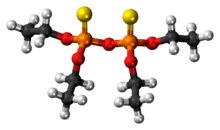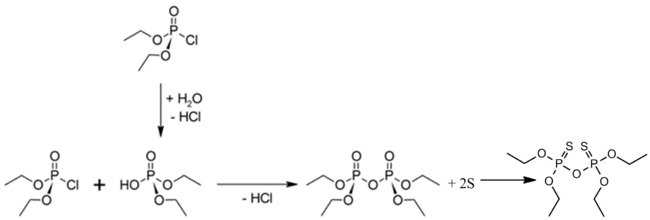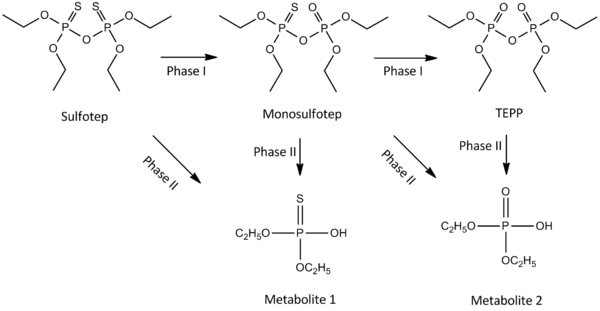Sulfotep
 | |
 | |
| Names | |
|---|---|
| IUPAC name
diethoxyphosphinothioyloxy-diethoxy-sulfanylidene-λ5-phosphane | |
| Other names | |
| Identifiers | |
| 3689-24-5 | |
| 3D model (Jmol) | Interactive image |
| ECHA InfoCard | 100.020.905 |
| PubChem | 19395 |
| UNII | V41BK2EE8X |
| |
| Properties | |
| C8H20O5P2S2 | |
| Molar mass | 322.318922 g/mol |
| Appearance | pale yellow liquid[3] |
| Odor | garlic-like[3] |
| Density | 1.196 kg/cm3 |
| Melting point | not available |
| Boiling point | 136 to 139 °C (277 to 282 °F; 409 to 412 K) at 2 mm Hg |
| 30 mg/l in water | |
| Vapor pressure | 0.0002 mmHg (20°C)[3] |
| Hazards[4][5] | |
| NFPA 704 | |
| Flash point | −18 °C (0 °F; 255 K) |
| not available | |
| Lethal dose or concentration (LD, LC): | |
| LD50 (median dose) |
22 mg/kg (mouse, oral) 25 mg/kg (rabbit, oral) 5 mg/kg (dog, oral) 5 mg/kg (rat, oral)[6] |
| LC50 (median concentration) |
38 mg/m3 (rat, 4 hr) 40 mg/m3 (mouse, 4 hr)[6] |
| US health exposure limits (NIOSH): | |
| PEL (Permissible) |
TWA 0.2 mg/m3 [skin][3] |
| IDLH (Immediate danger) |
10 mg/m3[3] |
| Except where otherwise noted, data are given for materials in their standard state (at 25 °C [77 °F], 100 kPa). | |
| Infobox references | |
Sulfotep (O,O,O',O'-Tetraethyldithiopyrophosphate) is a pesticide commonly used in greenhouses as a fumigative agent. The substance is also known as TEDP, Dithione, Dithiophos and many others. Sulfotep belongs to the class of chemicals named organophosphates. It has a cholinergic effect, involving depression of the cholinesterase activity of the peripheral and central nervous system.[5] The transduction of signals is disturbed at the synapses that make use of acetylcholine.
History
Discovery
Sulfotep was first commercially launched by BAYER in 1946. It is known as an organophosphate, which were also used for war efforts by British and German armies before use in agriculture developed. 2 Sulfotep is synthesized by a reaction of TEPP (tetraethyl pyrophosphate) with sulfur. Tepp itself was first synthesized by Philipe de Clermont in 1854.,[7]
Incidents
The Dutch company BASF produced and stored sulfotep until 2004. The storage room was repurposed as an office. Some employees complained about lung problems after having worked in those offices.[8]
A gardener who tried to commit suicide took an unknown number of Sulfotep-cointaining compounds. They caused severe intoxication (unconsciousness, vomiting, cyanosis, gasping, pulmonary edema, clonic-tonic convulsions). Treatment with atropine was successful. Cholinesterase activity in the serum was 70-80% lower at day one and 35% lower at day 10.[9]
Use as insecticde
Sulfotep is used in greenhouses as a fumigant formulation to control aphids, spider mites, whiteflies and thrips. It is formulated as impregnated material in smoke generators containing 14 to 15% active ingredient. Smoke generators are placed in the greenhouses and then ignited using inserted sparklers to generate a thick white smoke for fumigation.
Structure and synthesis

Sulfotep is made by a reaction from tepp and sulfur. An alternative route can be a reaction of diethyl chlorothiophosphate and water in a mixture of Na3CO3. Tepp is made by a reaction of diethylchlorophosphate with water to substitute the chloro-group with a hydroxyl-group. The product can react with another molecule of diethylchlorophosphate to form an ester, the tepp molecule. In this reaction pyridine is often used to clear the reaction from the HCl.[10]
Available forms
At room temperature sulfotep is a colourless liquid oil. Its boiling point is only available at low pressure. Only at low pressure and high temperature sulfotep is available as a gas. Because of the flash point of -18 °C there is a vapor present at room temperature. The gas is heavier than air. Sulfotep has a garlic-like odor.[11]
Mechanism of action
Sulfotep, just as all organophosphate pesticides, irreversibly inactivates acetylcholinesterase, which is essential to nerve function in insects, humans, and many other animals. Acetylcholinesterase normally hydrolyses acetylcholine after it was released in the synaps. When the acetylcholine is not degraded, it accumulates in the synaptic cleft. Thus it keeps on stimulating the nerve.[12]
Metabolism
Uptake
Sulfotep is taken up well both orally, dermally as well as through inhalation. A few different organizations determined a maximum concentration sulfotep in the air. The maximum allowed concentration is 0.2 mg/m3.

Phase I
Sulfotep is desulfurated by either cytochrome P450 or the FAD-containing monooxygenases. In this reaction, the sulfur is replaced by oxygen, as seen in figure 2. The metabolites formed are monosulfotep and tetraethyl pyrophosphate (TEPP). To accomplish these reactions, a phospho-oxithirane ring is formed, which is highly reactive. This ring is thought to bind to acetylcholinesterase and cause toxicity.[13]
Phase II
The two Phase I metabolites are further transformed through a hydrolysis-reaction mediated by a type A-esterase. The products formed are O,O-Diethyldithiophosphate and O,O-Diethylphosphate. The complete metabolism can be found in figure 2.[13]
Excretion
An experiment in rats who were once given 0,4 mg radioactive phosphor-labelled sulfotep orally, has shown that sulfotep is excreted by both the kidneys (urine) and the liver (bile). The substance is completely metabolised. Two metabolites are found in the urine and faeces. The radioactivity showed that 85-91% was excreted in urine and 5-6% in the faeces.[12]
- 88-96% metabolite 1: O,O-Diethyldithiophosphate
- 4-12% metabolite 2: O,O-Diethylphosphate [2]
Toxicity
Acute toxic effects on animals
In the table below you can find the results of different experiments done on different animals. Dogs and cats best mimic the effects found in humans.
| Exposure | Toxic level |
|---|---|
| Inhalation | mg/m3 |
| Mouse 1 hr | 155 [2][11] |
| Mouse 4 hr | 40 [2][11] |
| Rat 1 hr | 160-330 [2][11] |
| Rat 4 hr | 38-59 [2][11] |
| Oral LD50 | mg/kg |
| Cat | 3 [2][11][14] |
| Dog | 5 [2][11][14] |
| Mouse | 21.5-29.4 [2][11][14] |
| Rabbit | 25 [2][11][14] |
| Rat | 5-13.8 [2][11][14] |
| Dermal LD50 | mg/kg |
| Rat 4 hr | 262 [2] |
| Rat 7 d | 65 [2] |
| Intravenous LD50 | μg/kg |
| Mouse | 300 [2][14] |
| Intramuscular LD50 | μg/kg |
| Mouse | 500 [2][14] |
| Rat | 55[2][14] |
| Intraperitoneal LD50 | μg/kg |
| Mouse | 940[2][14] |
| Rat | 6600[2][14] |
| Subcutaneous LD50 | mg/kg |
| Mouse | 8[2][14] |
Surviving animals completely recovered in 1–4 days.
Chronic and sub-chronic toxicity
A long-term exposure to a low concentration showed no toxicity. This was tested in rats. They were exposed to different concentrations of sulfotep. Exposed to the highest concentration of 2.83 mg/m3 for six hours a day, five days a week for 12 weeks, there was no change in appearance, behavior or body weight. The plasma cholinesterase activity decreased and the weight of the lungs of female rats increased. The red blood cell acetylcholinesterase activity was not affected. At lower concentrations, there were no changes at all. The rats were orally exposed to 0, 5, 10, 20 or 50 ppm sulfotep for three months. Only their plasma cholinesterase activity and RBC acetylcholinesterase activity were decreased. No further symptoms were observed. Dogs who were orally exposed to 0, 0.5, 3, 5, 15 or 75 ppm (equivalent to 0–3.07 mg/kg/day) for 13 weeks, ate less and lost weight. The plasma cholinesterase activity was already affected by a sulfotep concentration of 3 ppm (or higher). Red blood cell-acetylcholinesterase was decreased at 75 ppm. Diarrhea and vomiting occasionally occurred at 15 ppm, but were common at 75 ppm. The brain cholinesterase activity was unaffected.[11]
Poisoning symptoms and treatment
Sulfotep causes an organophosphate poisoning. This means that it had an effect on the activity of cholinesterase. There are differences for the indications of a sulfotep poisoning between inhalation, ingestion, intake by the skin and intake by the eyes. However, examples of poisoned greenhouse workers teach us an overall route of symptoms for a sulfotepp poisoning. Within the first hour after a poisonous intake of sulfotep people often suffer from nausea or headaches. After some hours diarrhea and vomiting may occur. People who inhaled sulfotep are often disorientated and have difficulties to breath. A poisonous dose may lead to a coma or death after 24 hours. The point at 24 hours after the poisoning is very important. If the dose is not lethal, the symptoms will slowly disappear after the point of 24 hours.[15][16]
No embryotoxic or teratogenic effects occurred in tests. Neither were there any signs for carcinogenic effects. It was only mutagenic in one strain of S. typhimurium. In four other bacterial strains as well as in rats and mice it was not mutagenic at all. There are two cases of acute toxicity known in man. The cholinesterase activity in these people was reduced. It took them 20 respectively 28 days to recover.[11] The most important poisoning symptoms are shown in the following table.[17]
| Exposure | Symptoms | First aid treatment | Other treatments |
|---|---|---|---|
| Inhalation | blue skin, convulsions, dizziness, drowsiness, headache, sweating, labored breathing, nausea, unconsciousness, weakness | Fresh air or artificial respiration. Rest is important to prevent a respiration-arrest | |
| Ingestion | cramps in intestines, diarrhea, vomiting, confusion | Vomiting may only be induced in conscious people | Active charcoal to absorb compound. Atropine as an antidote |
| Eyes | irritation, redness, constriction of the pupil, loss of focus | Rinsing with plenty of water will lead to recovery of sight within 24 hours | |
| Skin (may be absorbed) | redness, irritation, sweating, twitching of the area | First rinse with plenty of water. Then wash the skin with water and soap | |
References
- ↑ Eula Bingham, Barbara Cohrssen and Charles H. Powell. ‘’Patty’s toxicology’’ (5th edition. Vol. 7. John Wiley and sons inc.)
- 1 2 3 4 5 6 7 8 9 10 11 12 13 14 15 16 17 18 19 Pub chem: sulfotepp. Cid: 19395 http://UNII = V41BK2EE8X 2 PubChem.ncbi.nlm.nih.gov/summary/summary.cgi?cid=19395
- 1 2 3 4 5 "NIOSH Pocket Guide to Chemical Hazards #0586". National Institute for Occupational Safety and Health (NIOSH).
- ↑ http://www.chemkoo.com/en/ProductDetail.aspx?ck=CK00174335
- 1 2 Georg Kimmerle and Otto R. Klimmer, ‘’Acute and Subchronic Toxicity of Sulfotep’’, Arch. Toxicol. 33, 1-16 (1974)
- 1 2 "TEDP". Immediately Dangerous to Life and Health. National Institute for Occupational Safety and Health (NIOSH).
- ↑ Toy, A. D. F. (1948). ‘’ The Preparation of Tetraethyl Pyrophosphate and Other Tetraalkyl Pyrophosphates.’’ J. Am. Chem. Soc. 70 (11): 3882. doi:10.1021/ja01191a104.
- ↑ ‘Klokkenluidster tegen wil en dank; werkomstandigheden. Ziek geworden werkneemster contra chemieconcern BASF.’ NRC Handelsblad, january 17th 2008
- ↑ 2012. Sulfotep [MAK Value Documentation in German language, 1997]. The MAK Collection for Occupational Health and Safety. 1–13.
- ↑ Thomas A. Unger , Pesticide synthesis handbook – page 387
- 1 2 3 4 5 6 7 8 9 10 11 12 Eula Bingham, Barbara Cohrssen and Charles H. Powell. Patty’s toxicology (5th edition. Vol. 7. John Wiley and sons inc.)
- 1 2 Sulfotep, Bayer MAK 24, Lieferung 1997
- 1 2 Timbrell John A., Principles of biochemical toxicology 4th edition 2009. Informa Healthcare New York. pp 91 & 99
- 1 2 3 4 5 6 7 8 9 10 11 Richard J. Lewis, Sr. Sax’s Dangerous properties of industrial materials (10th edition. Vol. 3. John Wiley and sons inc.)
- ↑ http://www.cdc.gov/niosh/ipcsndut/ndut0985.html
- ↑ Chemwatch, Sulfotep sc-251093. Material Safety Data Sheet. https://datasheets.scbt.com/sc-251093.pdf
- ↑ International Chemical Safety Cards, ICSC: 0985, http://www.cdc.gov/niosh/ipcsndut/ndut0985.html
External links
- Sulfotep in the Pesticide Properties DataBase (PPDB)
